
Mid Sized Trees
Spacing of 20 to 30 feet

Scientific Name: Fraxinus americana ‘Autumn Purple’
Size: 35′ X 30′
Drought Tolerance: Average
Native Plant: No
Fall Color: Deep Reddish Purple
Edible Fruit: No
Growth Rate: Moderately fast
Comments:
The Autumn Purple Ash is a moderately drought tolerant tree that can withstand
the alkalinity of our soils. The fall color is a beautiful orange/purple.
Watch for sun scald on the trunk
in young trees and wrap them in the winter if they start to develop problems
with splitting bark.
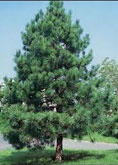
Scientific Name: Pinus Nigra
Size: 60′ X 30′
Drought Tolerance: High
Native Plant: No
Fall Color: Green
Edible Fruit: No
Growth Rate: Moderate
Comments:
The Austrian Pine is a large, hardy, drought-tolerant pine tree. It is one
of the most adapted pine trees for our area.

Scientific Name: Sorbus aucuparia
Size: 35′ X 24′
Drought Tolerance: High
Native Plant: No
Fall Color: Reddish-Purple
Edible Fruit: The fruit is edible but bitter
Growth Rate: Moderately Slow
Comments:
The Mountain Ash is a very drought tolerant tree with beautiful white flowers,
great fall color and red fruit. It is subject to many diseases and pests
including borers and fire blight.
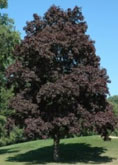
Scientific Name: Acer platanoides
Size: 40′ X 30′
Drought Tolerance: Average
Native Plant: No
Fall Color: Yellow
Edible Fruit: No
Growth Rate: Moderate
Comments:
The Norway Maple is a dense tree with a round head that casts deep shade.
It is adapted to our harsh conditions, has great fall and summer color
and is easy to grow. It does tend
to be over planted in Utah despite problems with aphids and sunscald
on the trunk. Seedlings can become
invasive in lawns.
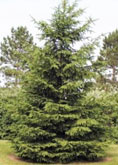
Scientific Name: Picea abies
Size: 40′ X 30′
Drought Tolerance: High
Native Plant: No
Fall Color: Green
Edible Fruit: No
Growth Rate: Moderately Fast
Comments:
The Norway Spruce is larger tree that is drought tolerant and is well-adapted
to our area. Deer do like to browse the growth tips of this tree in the
spring.
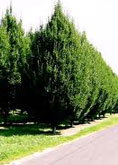
Scientific Name: Carpinus betula ‘Fastigiata’
Size: 40′ X 30′
Drought Tolerance: Average
Native Plant: No
Fall Color: Bright Yellow
Edible Fruit: No
Growth Rate: Moderate
Comments:
Pyramidal Hornbeams are hardy trees with a very formal appearance. They
are moderately drought tolerant, and adapted to our harsh conditions.
They have fabulous gold fall color.
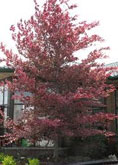
Scientific Name: Fagus sylvatica ‘RoseoMarginata’
Size: 30′ X 20′
Drought Tolerance: Poor
Native Plant: No
Fall Color: Copper
Edible Fruit: Yes
Growth Rate: Slow
Comments:
Tricolor Beech trees are fantastically beautiful trees that needs to be
planted in an area protected from the sun. The multicolor leaves scald
easily. These trees are not drought
tolerant and do need slightly acidic soil for better leaf color.

Scientific Name: Tilia cordata ‘Greenspire’
Size: 40′ X 30′
Drought Tolerance: Average
Native Plant: No
Fall Color: Bright Yellow
Edible Fruit: No
Growth Rate: Moderate
Comments:
The Little Leaf Linden is an over planted tree in our area. It is not drought
tolerant but is very hardy in Utah conditions. It has a nice pyramidal
shape and highly fragrant flowers
in the summer. The seeds can be messy.
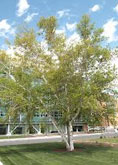
Scientific Name: Betula papyrifera
Size: 35′ X 30′
Drought Tolerance: Poor
Native Plant: No
Fall Color: Yellow
Edible Fruit: No
Growth Rate: Moderately Fast
Comments:
The Paper Birch tree has beautiful white, exfoliating bark and nice golden
fall color. It needs a lot of moisture to look good. It is tolerant of
our alkaline soil and is very salt
tolerant.
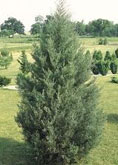
Scientific Name: Juniperus virginiana
Size: 50′ X 25′
Drought Tolerance: High
Native Plant: No
Fall Color: Green
Edible Fruit: No
Growth Rate: Moderate
Comments:
The Eastern Red Cedar is very drought tolerant and hardy in our area. It
is a great tree to plant in tough conditions. Deer do tend to browse
this tree when the winters are harsh.
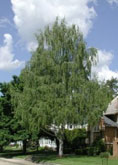
Scientific Name: Betula Pendula
Size: 35′ X 25′
Drought Tolerance: Poor
Native Plant: No
Fall Color: Yellow
Edible Fruit: No
Growth Rate: Fast
Comments:
The European White Birch is a beautiful tree with white bark and a weeping
habit. It needs more moisture than most trees but is hardy in our area.
It tends to be affected by borer
when stressed. Keeping the tree in moist, cooler conditions helps it
avoid stress.
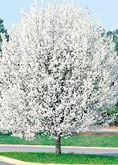
Scientific Name: Pyrus calleryana ‘Aristocrat’
Size: 36′ X 25′
Drought Tolerance: Average
Native Plant: No
Fall Color: Purplish-Red
Edible Fruit: No
Growth Rate: Fast
Comments:
This flowering pear’s branches are more broadly spaced than others so it
is more able to withstand wind and snow without breakage. It has beautiful
but mal odorous spring flowers.
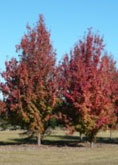
Scientific Name: Pyrus calleryana ‘Redspire’
Size: 30′ X 25′
Drought Tolerance: Average
Native Plant: No
Fall Color: Purplish-Red
Edible Fruit: No
Growth Rate: Fast
Comments:
The leaves on this pear tree are reddish in the spring and it has beautiful
but mal odorous spring flowers. The fall color is spectacular. This tree
is fast growing and the branches
are prone to breakage.

Scientific Name: Albizia julibrissin
Size: 35′ X 30
Drought Tolerance: Average
Native Plant: No
Fall Color: None
Edible Fruit: No
Growth Rate: Fast
Comments:
Mimosa trees are very pretty trees with fragrant, pink blooms that bloom
all summer. They are marginally hardy in our area (zone 6) but there
are several beautiful specimens in
Pleasant Grove so they are worth trying. They have average drought tolerance
but do not suffer damage from
many pests. They do tend to suffer winter dieback especially in colder
areas. The flowers continue throughout
the summer and attract hummingbirds.
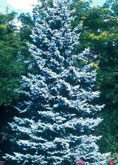
Scientific Name: Picea pungens ‘Bakari’
Size: 35′ X 20′
Drought Tolerance: Average
Native Plant: No
Fall Color: Blue
Edible Fruit: No
Growth Rate: Moderate
Comments:
The Bakari Blue Spruce is a smaller blue spruce with very blue foliage.
It has moderate drought tolerance and does not suffer from many pests
as long as it gets enough water.
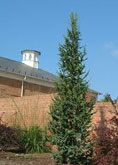
Scientific Name: Cedrus atlantica ‘Glauca Fastigiata’
Size: 35′ X 20′
Drought Tolerance: Average
Native Plant: No
Fall Color: Green
Edible Fruit: No
Growth Rate: Slow
Comments:
The Columnar Atlas Cedar is a slow growing tree that is quite beautiful.
It does need good drainage and protection from harsh winters to do well.
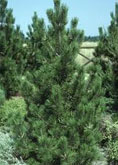
Scientific Name: Pinus leucodermis
Size: 35′ X 15′
Drought Tolerance: High
Native Plant: No
Fall Color: Green
Edible Fruit: No
Growth Rate: Slow
Comments:
The Bosnian Pine is a slow growing, narrow pine tree that is well adapted
to our area. It is quite drought tolerant and very beautiful. It has
few pests.

Scientific Name: Koelreutaria paniculata
Size: 30′ X 30′
Drought Tolerance: High
Native Plant: No
Fall Color: Yellow
Edible Fruit: No
Growth Rate: Moderate
Comments:
The Golden Rain Tree has very beautiful yellow flowers and unusual seed
pods shaped like lanterns that can be messy in the fall. They are very
drought and salt tolerant and do
well in our area. One issue with Golden Rain Trees is weak branch patterns
that make them susceptible to
breakage in storms.
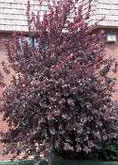
Scientific Name: Prunus virginiana
Size: 30′ X 20′
Drought Tolerance: Average
Native Plant: No
Fall Color: Purple
Edible Fruit: Yes
Growth Rate: Fast
Comments:
This tree starts out green in the spring and changes to purple in the summer.
The white flowers are very fragrant. It does have a habit of suckering
extensively but can be grown as
a single trunk tree with effort, or a multi trunk shrub. This tree grows
well in areas that receive average
water and have good drainage. The fruit is edible but is very astringent.
The berries make wonderful jams
or fruit leather. Eating them straight from the tree is not pleasant.
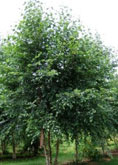
Scientific Name: Betula nigra
Size: 35′ X 20′
Drought Tolerance: Poor
Native Plant: Yes
Fall Color: Yellow
Edible Fruit: No
Growth Rate: Fast
Comments:
The River Birch is a beautiful multi-trunked tree with reddish bark. It
does best in areas with a lot of moisture and lower PH, but will survive
in areas with less moisture and
moderate alkalinity.

Scientific Name: Syringa reticulata
Size: 25′ X 20′
Drought Tolerance: Average
Native Plant: No
Fall Color: None
Edible Fruit: No
Growth Rate: Moderate
Comments:
The Japanese Tree Lilac is a beautiful, small, hardy tree. It has white
flowers in the spring and glossy foliage. It is tolerant of salt and
alkalinity. It does well in our area.

Scientific Name: Calocedrus decurrens
Size: 80′ X 12′
Drought Tolerance: High
Native Plant: No
Fall Color: Green
Edible Fruit: No
Growth Rate: Slow
Comments:
The Incense Cedar is a beautiful, narrow tree. It is slow growing and shade
tolerant. It is very drought tolerant once it gets established. The scaly
leaves are very aromatic. There
is a beautiful specimen growing by the BYU duck pond.
